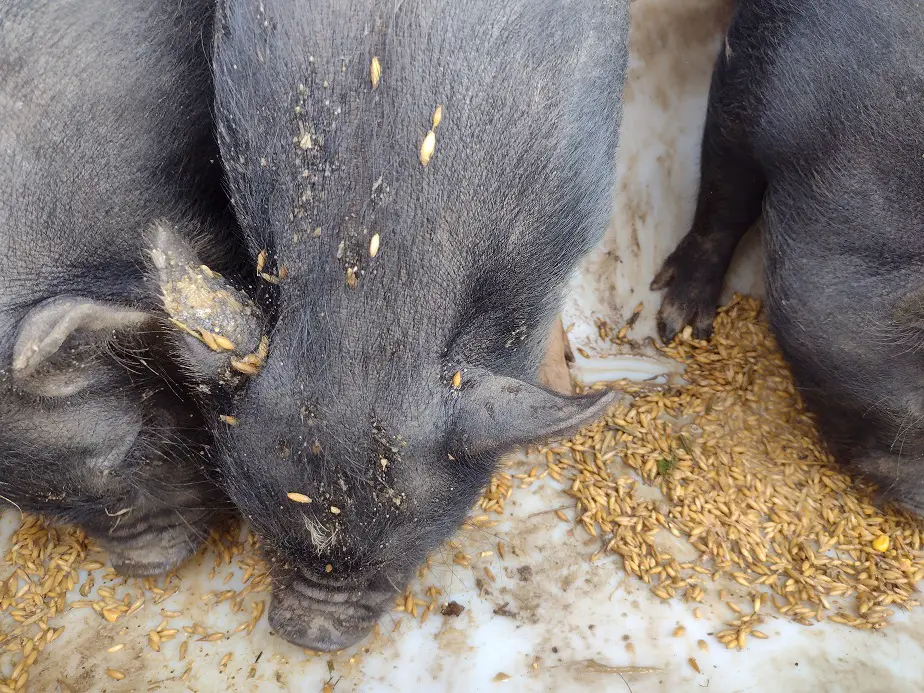I started raising animals out of necessity. For a long time, that was the only way I could afford decent meat was to raise it myself cheaper than store price.
You can save money on pig feed by understanding a pig’s dietary requirements, sourcing cheaper alternative feedstuffs, and reducing waste. Fermentation can help many feed items gain a higher digestibility for pigs, reducing needed intake. Keeping pigs stress-free pigs better utilize their feed.
I’ll tell you what I learned, and the methods we’ve used to feed pigs at half-cost.
Finding Cheaper Hog Feed
Current feed prices bring the cost of home-raised pork to $2/lb. Now, that’s for all cuts, not just the cheap ones. Still, I can buy cheap pork from the store for less than that. For the past 5 years, my goal has been raising my own pork at $1/lb. Even with the recent increases in feed costs, I’ve been able to hit that goal.
The first thing I do, or rather don’t do, is buy bagged hog feed. The most expensive way to feed a hog is to buy feed that comes in those 40 or 50-pound sacks from the farm store. Currently, that stuff costs between $15 and $20 a bag. While it may benefit a show hog, it’s not cost-effective.
To acquire cheaper feeds, you need to think a little outside the box. The first thing I’d check into is local grain elevators (places farmers sell feed crops to). They deal in bulk and sometimes have great prices, but often only if you buy in bulk, by the ton or half-ton. If you have a trailer or grain wagon, that can be done.
In my area, that’s not much cheaper than just buying a bagged, off-brand feed. You can usually get a much better price by buying either a basic feed mix or the basic ingredients from a local farmer. I get corn and wheat, the main ingredients of hog feed, for 30 percent less by cutting out the middle man.
Between that, and feeding our homestead waste product feedstuffs to the pigs, our feed bill stays quite low. When you know what goes into a decent hog feed, you will be able to find cheaper and alternative feedstuffs. Let’s talk but what pigs need to eat to be healthy and grow well.
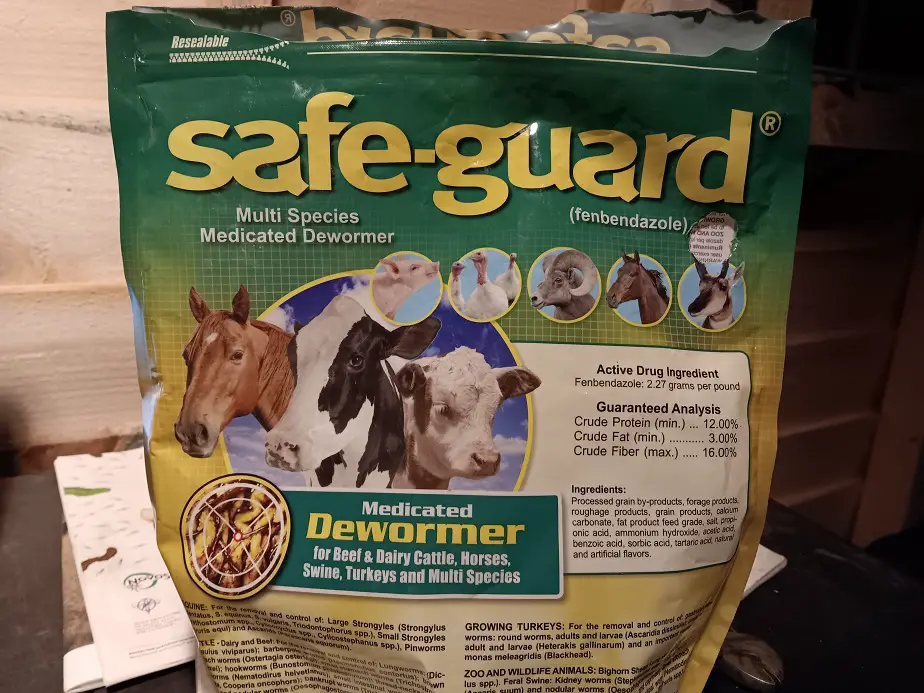
One thing you need for pigs, no matter your raising system, is a parasitic worm treatment. The best swine dewormer is Fenbendazole. It’s known by the brand name Safeguard. Safeguard is available as a medicated corn/alfalfa pellet. It’s the only way I can worm my pigs since they won’t stand still for an injection of Ivermectin. It’s easy and cheap.
- There is a stronger pellet for swine only. Here it is on Amazon
- There is a weaker pellet for general barnyard livestock, including swine. Here it is on Amazon.
I use the multi-species version because it’s what’s available in my local store and I can use it for my chickens too. It’s the most effective swine wormer and the easiest to administer. I use it on all weaned piglets and adults twice a year. Don’t go without it.
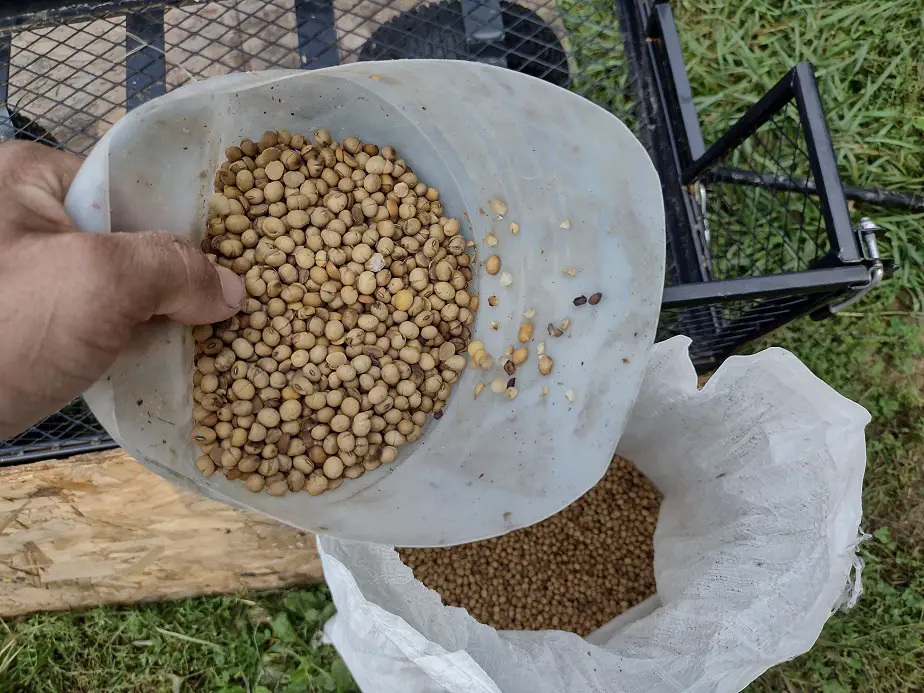
What Pigs need to eat to grow well
Pigs need a high-energy and high-protein diet to grow well. They also need a basic series of vitamins and minerals. Most hog feeds have a mix of corn, wheat, barley, oats or grease as the energy source, and flax, soybean, or peas as protein. Then a vitamin/mineral powder is added to keep them healthy.
Other common options include alternative feedstuffs such as restaurant waste, orchard culls, bakery leftovers, and reject grain products (cookies, breads, crackers) from factories. In some cases, slaughterhouse waste (fat, offal, meat scraps) are processed as an energy or protein source.
A basic hog ratio is something like 70 percent corn, 20 percent soybean, and 10 percent oats. Plus the added vitamin and mineral supplement. Pigs need protein levels between 12 and 18 percent, depending on breed and stage of growth. The protein needs of pigs are similar to that of people.
Grains have some protein, usually between 6 and 12 percent. but, they by themselves are poor protein for pigs. Pigs need 10 different amino acids, which are either synthesized or found in quality protein feedstuffs. Here are the amino acids pigs need.
- Arginine
- Histidine
- Isoleucine
- Leucine
- Lysine *considered the most important to have enough of
- Methionine
- Phenylolanine
- Threonine
- Tryptophan
- Valine
Protein is considered the largest limiting factor of a pig’s growth. Pigs also need fiber. Our pigs get fiber and their vitamins/minerals from a combination of wild greens and produce leftovers from the farmer’s market. With a decent mix of even just wild greens (grass, weeds, tree leaves) I can use a more basic feed.
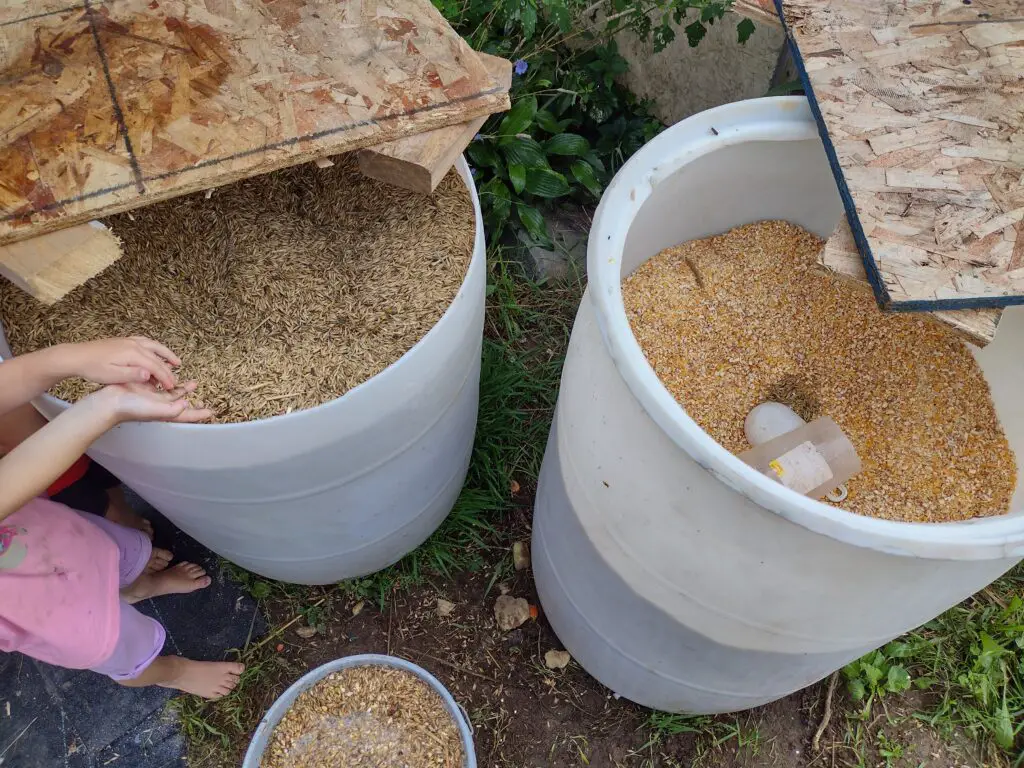
How to Mix Your Own Hog Feed
Mixing your own pig feed is s simple as getting your hands on a source of concentrated energy, like grains, and a quality protein source. In the US, the energy source is usually either corn or sorghum grain, and the protein is usually soy or peas. Here are some options
Proteins
- Flax seed or meal– 18%+ protein (low in lysine)
- canola seed or meal– 35% protein
- Sunflower seeds or meal– 30% protein
- Used distiller’s grain– 30% protein (When dry)
- Cottonseed meal– 30% protein
- Peanut, shelled– 50% protein
- Meat scraps 20-30% protein
- Blood meal– 95% protein (can be made after butchering animals)
- Acorns
- Milk or whey products– variable
All of these, except flax, have fairly complete protein profiles. Flax is low in lysine, which is considered the most significant limiting amino acid. Pig producers are always concerned about pigs getting enough lysine. Most of these would do as a single source of protein, but a variety is always better.
Energy sources
- Corn
- Wheat
- Oats
- Rye
- Barley
- bakery throwouts
- Fats ans oils
- Jerusalem artichoke
- Potato
- squash/pumpkin seeds
- Acorn or other nuts
- Orchard cullings (apple, pear etc.)
Basically, energy sources are starches. Fats and oils can be added, but should only be a supplement to a pig’s diet. The protein ingredients themselves can contain quite a bit of energy in the form of oil.
If you buy whole or whole ground soybean, peanut, sunflower, or flax, the oils present add a lot of calories and that allows you to add more vegetation, grass, weeds, and leaves, to a pig’s diet. The processed meal from these ingredients has had the oil removed and has lower energy values.
How do you know if your pig is getting enough energy? Observe their condition and behavior. if a pig is scrawny and not filling out; if it’s looking boney and thin, the pig needs either more feed or a higher concentration of energy in the feed.
Corn and wheat are considered the most digestible grains for hogs. But, they benefit from grinding. All whole grains and protein sources will benefit from some kind of processing to make them more digestible and to break down complex molecules, unlocking more nutrients.
The most common processing method is grinding. Roasting, flaking, steaming, and fermenting are also used. Seed meals are already processed by-products. Fermenting is the easiest processing method for small-scale farming, and it doesn’t require expensive equipment. All feedstuffs can be fermented.
Fermenting unlocks previously undigestable proteins, breaks down tough fibers into a more usable form, and increases the protein levels of a natural feed product. We ferment almost all our pig’s feed from vegetables to corn and oats. It helps growth, and even adds vitamin content to low-vitamin grains.
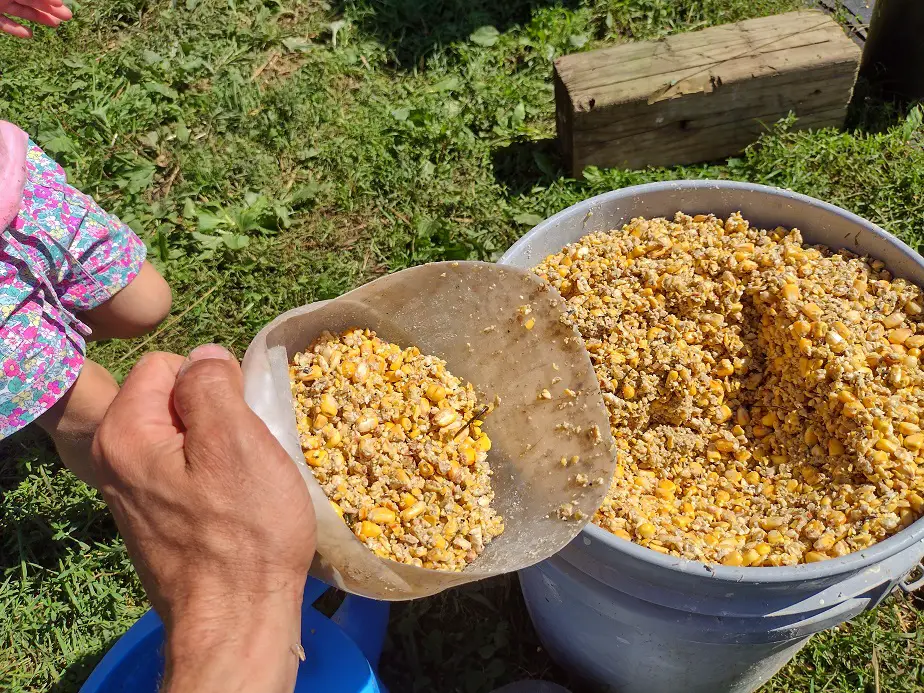
Recipes for Mixing your Own Basic Hog Feed
There are three main types of hog feed for different stages of development for a butcher hog. They are starters, growers, and finishers. Some pig farmers split each into two categories and formulate specific feeds for each to eke out a tiny bit lower cost. I say keep it simple. Here are a few basic formulations.
*Ingredients are measured by weight
- 18% Protein: 11 parts corn, 5 parts soybean
- 17% Protein 5 parts corn, 2 parts soybean
- 16% Protein: 3 parts corn, 1 part soybean
- 15% Protein: 7 parts corn, 2 parts soybean
- 14% Protein: 4 parts corn, 1 part soybean
Keep reading to find out at what age to feed different formulations.
Corn is the standard, but most grains can replace it. However, not all grains have the same caloric value so replacing corn outright will alter the overall nutrition of a diet formulation. But, that’s not necessarily all bad. Most grains have fewer calories from starch but more calories from protein and oil than corn does.
Most other grains have around 80% of the energy value of corn. It’s not a huge deal, but it’s something to keep in mind. That may simply mean feeding 10-20 percent more of your feed mix. Some companies just add fats or oils to boost the caloric value. A tablespoon of grease or oil would balance that out.
Corn is known to produce a softer porkfat, containing more unsaturated fats than other grains. Oats are known to create a firmer fat, which about 60 years ago became undesirable. Feeding more than 20 percent oats in a diet is supposed to make the fat “undesirable”, but I disagree.
My pigs get about 50:50 corn and oats. Now, that’s fermented so everything has changed nutritionally and perhaps that’s why I like the resulting fat. Our pigs don’t get much protein other than the fermented grains which should be approximately 14%.
Studies have shown that feed containing more than 15 percent protein has no increased effect on pig growth after 3-4 months. Older pigs and slower-growing breeds don’t need as much.
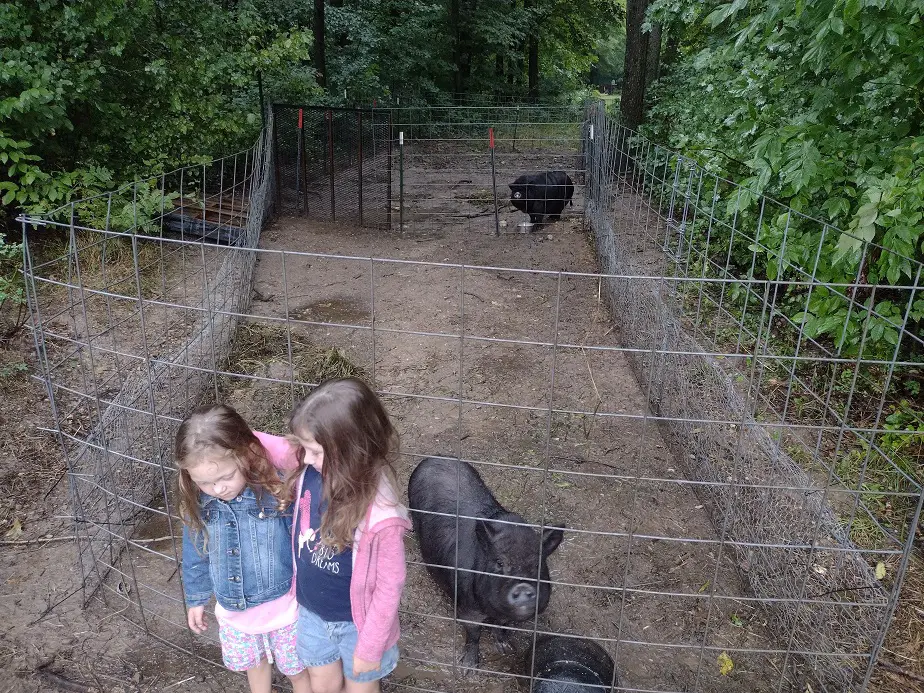
Feeding Pigs Based on Their Maturity
pig feeds are grouped into 3 main categories; starter, grower, and finisher. Starter feed is for pigs not quite weaned or just weaned. It’s their start in solid foods. Grower feed is for fully weaned pigs that are used to solid food, up to 4 months old. Finisher feed is for pigs 4-9 months old.
The difference is in protein content and in digestability, or simple ingredients. Weanling pigs are usually given feed with things like whey and dry milk to up the protein and calcium. As they get older, their protein needs go down and their stomachs can handle harder-to-digest nutrient additives like hay.
Personally, I don’t mix much other than basic fermented grains and a little soybean. They get kitchen scraps and wild greens on the side. While it’s highly recommended, I don’t give our pigs a mineral and vitamin supplement block or powder. I rely on a variety of forage and vegetation and watch them closely.
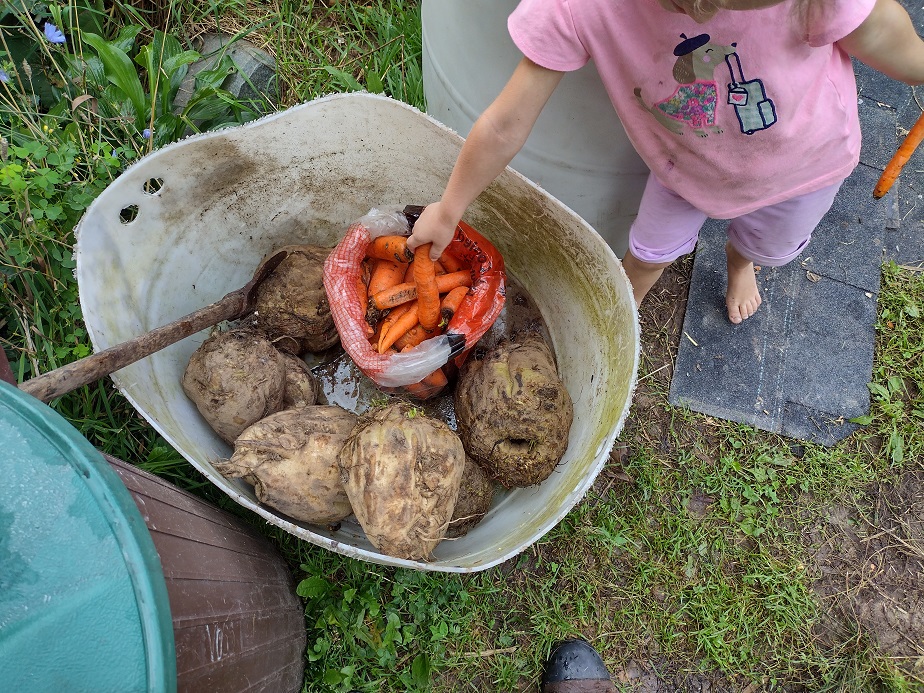
Feeding Food Waste to Pigs
Feeding waste to pigs is a great way to get good growth for little money. The most basic is saving your kitchen scraps. The average family, especially if doing a lot of home cooking, produces enough scrap food to significantly improve a pig’s diet. Nothing edible goes to waste.
literally everything from fruit peels to meat trimmings and grease from the frying pan can go to the pigs. We save it all up in a coffee can and give it to the pigs every morning. Dirty dishes get scrapped into the scrap can along with soured milk, bad produce, and freezer-burned meats.
Beyond that, you may be able to collect kitchen waste from friends and neighbors, or from restaurants. Restaurants have a ton of wasted food. I’m always surprised at how many people throw out half a plate of good food. A lo of restaurants will set the food scraps out by the dumpster for you if you ask.
If you do use restaurant food scraps, it’s advised to put it in a large pot and simmer it to kill any pathogens that may have gotten in it. I’ve done that outside over a small campfire
Bakery waste is often collected and sold through feed distributors, but small bakery shops have to deal with it themselves. You can contact a small bakery to see if you could help them dispose of their baked goods. Bakery leftovers can replace corn, by weight, in a feed formulation.
One last idea is to contact a grocery store about repurposing their waste. Grocery stores are gluttons for throwing away old or outdated foods and soggy produce. If you have a friend in any food preparation, food transportation, or food sales facility, You have an in on cheap ways to feed a hog.
When feeding food waste, you don’t know the total feed value or nutrition. You probably don’t know the total nutrition of what you ate for breakfast either. One of the things that I learned to do was eyeball the nutrition levels, just like I do for myself when it’s dinner time. Use grains and soy to balance things out.
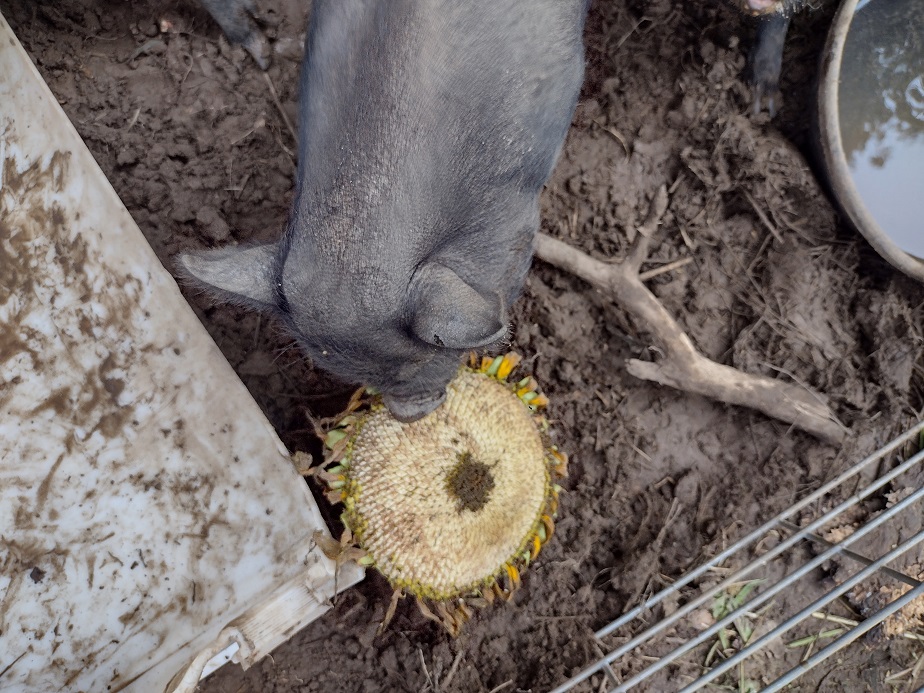
Growing Your Own Feed For Pigs
Growing grains, beans, and vegetable crops is the most sustainable way to feed pigs. 1/4 acre can grow enough feed for 3 commercial breed pigs. An acre planted with corn and beans can feed 13 pigs from weaning to butcher.
Even without fancy equipment, you can plant 1/4 acre of corn and beans. All you have to do is get a $120 push-along planter, seeds, and some fertilizer. Bonus if it’s irrigated. We grow corn and sunflowers (for sunflower seeds) as feed crops for our pigs.
This year we grew Jerusalem artichokes to try out. They are supposed to be a decent energy source so we’ll see how it goes. I’ve grown fodder beets and sugar beets for the pigs, but they’re high in fiber and the pigs don’t always like to eat them.
During mast years, when the acorns are in abundance, we go through the woods with pails gathering the wild nuts for our pigs. I let them fully dry to cure, then soak or ferment small batches for 3-5 days to make them more digestible. the water gets tossed and the pigs get their oak nuts.
You can do that with any wild nut. Most are high in tannic acid, which negatively impacts a pig’s digestion abilities but cracking and soaking them will rinse a lot of that out making them good to go.
Good Shelters Reduce Feed Intake Needs
My last point here is about shelter. Good shelter protects pigs from wind, rain, and sun exposure. All those things make a pig burn more calories, resulting in the need for more feed. Pigs should be kept in a functional, waterproof shelter.
A cold, wet pig will need about twice as much feed just to maintain body temperature and basic body functions. If it’s windy, that can be even more. In winter, giving pigs a dry, protected place with good dry straw to bed into will save you money by reducing the feed bill substantially.
Related articles:

